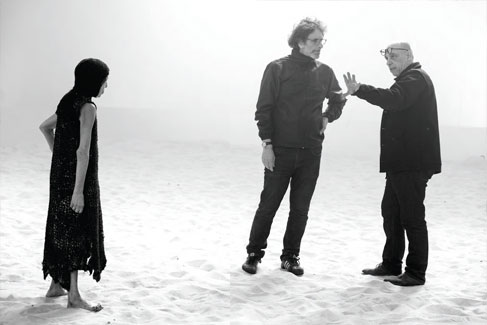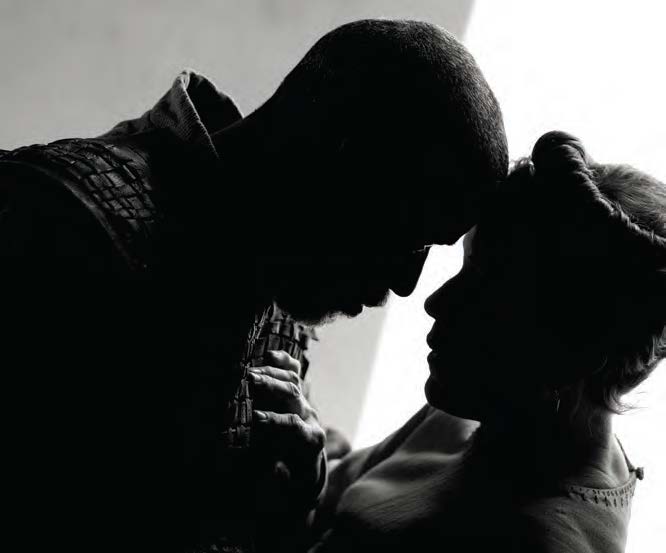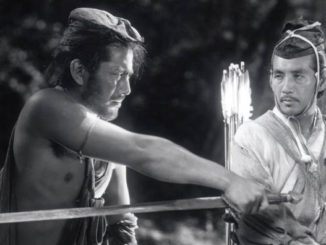
By Peter Tonguette
For close to 40 years, the credit “Edited by Roderick Jaynes” has been something like a mark of quality in American movies.
The credit has appeared on, among others, “Blood Simple” (1984), “Fargo” (1996), “O Brother, Where Art Thou?” (2000), and “No Country for Old Men” (2007) — all of which were written, produced, and directed by filmmaking siblings Joel and Ethan Coen, who also adopted the moniker “Roderick Jaynes” on the frequent occasions when they pseudonymously edited or co-edited their own movies. (The duo has also worked with other editors from time to time.)
Now, with Ethan Coen having, for now, stepped aside from his longtime filmmaking partnership with his brother, “Roderick Jaynes” has gone by the wayside, too. Enter picture editor Lucian Johnston – and yes, that’s his real name.

Joel Coen’s new Shakespeare adaptation “The Tragedy of Macbeth” — boasting a dazzling cast that breathes fresh life into the Bard’s words, including Denzel Washington as Macbeth, Frances McDormand as Lady Macbeth, and Alex Hassell as Ross — was adapted and directed by Joel alone. Johnston, who had been an assistant editor on the siblings’ previous project, “The Ballad of Buster Scruggs” (2018), co-edited the film with Joel (now using the pseudonym “Reginald Jaynes”). Together, they crafted a brilliant, piercing film that preserves both the majesty of Shakespeare’s language and the immediacy of the playwright’s plotting.
The best way to learn about Shakespeare is to edit it.
Johnston, a native of upstate New York, entered Sarah Lawrence College to study writing, but an adolescent passion for filmmaking kept rearing its head. After graduation, Johnston rose through the ranks of the postproduction world in New York, accumulating credits as an apprentice and assistant editor before becoming a picture editor on Ari Aster’s “Hereditary” (2018), co-edited by Jennifer Lame, and “Midsommar” (2019). But it was Johnston’s experience working with the Coens on “Buster Scruggs” that best prepared him to work side by side with “Reginald Jaynes” on “The Tragedy of Macbeth,” which is in theaters and on Apple TV+ now.
CineMontage recently spoke with Johnston about his work on the picture.
Q CineMontage: How did you first come to work with the Coens?
Lucian Johnston: I met Joel and Ethan through their post supervisor Catherine Farrell. I had done a few films with her as an assistant editor, and she thought I would be a good fit on “The Ballad of Buster Scruggs.” My duties on that film were mostly the traditional assistant editor duties. Joel wanted to work on weekends, and I volunteered to do that. Every weekend, Joel and I would cut one-on-one together. That was an incredible learning experience for me, and I guess what you could call the start of our collaboration.

When he was crewing up for “The Tragedy of Macbeth,” it was going to be the first movie that he was doing without Ethan. I think for Joel, the editing process really functions like a conversation. He needs to have someone next to him to be a soundboard and to bounce ideas off of. I was maybe a natural choice because we had just done that together on “Buster Scruggs.” I had also gone on to edit a few features with Ari Aster, and I think he trusted that I had developed more as an editor.
Q CineMontage: From your vantage point as an assistant editor on “Bust-er Scruggs,” how did Joel and Ethan work together?
Johnston: It is really a true collaboration. They would create screening sequences of every single scene, and they would work in chronological order. They would watch all the dailies for any given scene in order, and we would make editor notes. Then we would sit down and Ethan would first go through all of his notes and make in and out points on all the clips that he thought should be used in the film. He would do that in a very precise, surgical way. Then we would take all the clips that he thought should be used and lay them into a timeline.
Assembly is a great way to learn about the film.
It would be this kind of prosaic assembly from Ethan, and then Joel would take Ethan’s work — the fundamental structure that he had created — and would start working off of that. He would start smoothing it out and really fine-cutting that in a timeline.
Q CineMontage: Now you are working with Joel alone on “The Tragedy of Macbeth.” Was the collaboration different from what you observed of Joel and Ethan?
Johnston: It was similar and different. Obviously, the standard way that you start editing a film is that you do an assembly. Joel is so used to editing his own movies, he’s never screened an assembly before. I still kind of needed to do that for my own edification and to learn the language of the movie, because that’s really what an assembly is: it’s a chance to learn about the film.
We decided that I was still going to do an assembly of the movie the way that I normally would, but that Joel was not going to screen the assembly before we started working together. Instead, he wanted to have his own shot at piecing together every scene from scratch without looking at anything I had done so that he wasn’t biased by my instincts.
Basically, Joel did his version of a scene, completely unprejudiced by my version, then he looked at my version, and then we kind of combined them. It was kind of like working with Ethan, only in the sense that by the time we had finished the first half of the movie, it was really like we had made three passes of the film: my pass, his pass, and this combination pass. But unlike when he worked with Ethan, Joel wasn’t working off of my assembly. He was working off of his own instincts and then he was integrating my assembly into his work.
Q CineMontage: Do you think this unique process benefited the final film?
Johnston: Oh, absolutely. It resulted in an incredibly polished first cut. Our first cut of the movie was 1 hour, 45 minutes, and the final cut of the movie ended up being 1 hour, 41 minutes. My experience with assemblies is that they are usually much, much, much longer than the final version. It was very close to being there, at least big picture-wise, the first time we went through it.
Q CineMontage: Do you think the nature of the material contributed to the first cut being so close?
Johnston: That’s a big part of it. We were liberated from all the kind of macro structural things that you are concerned with on a typical film. “Macbeth” is such tried-and-true material. We weren’t going to rewrite the story in the edit. We were liberated from worrying about those things. We had the luxury of being able to focus on the fine cutting and the more micro, structural editing.

Q CineMontage: Does Joel shoot a lot of coverage?
Johnston: Everything is incredibly meticulous and well prepared. I’d say the average number of takes per setups that Joel did was probably four. Sometimes you would get to five; some you would get to six and seven. That’s a product of being so, so well prepared and having everything so well designed.
Q CineMontage: How did you shape the performances in the edit?
Johnston: Frances and Denzel are just incredible performers. It’s one of those good problems to have because there’s such a wealth of material. It’s very, very difficult to hone in and pick the right performances. The film is so much about language, and so we used so much line tracking and line swapping to augment performance. You do that in every movie, but to the extent we were doing that in this film, and the surgical precision with which we were doing it, was at a level that I had never done before. We had our first assistant editor, Max Berger, who’s fantastic, stack every single line in the movie in sequences. We could go to any line in the movie, press play, and hear every iteration of the line. We started doing line swaps in the movie, and then the line swaps became word swaps, and then the word swaps became swapping out other letters and other syllables.
Q CineMontage: In preparing for the movie, did you study “Macbeth,” including the previous film versions by Welles, Kurosawa, Polanski, and other directors?
Johnston: I watched all those movies, and I read the play many, many times over. I read a lot of theory and analysis of “Macbeth,” specifically Harold Bloom’s “A Dagger of the Mind.” I did a lot of homework, but what I found interesting was that the best way to learn about Shakespeare, and to really engage with the material, was just to edit it. It wasn’t until I started really watching dailies over and over again, and working with the material in context, that I really felt like things started to click. If every high school student could edit a scene of “Macbeth,” they would all get straight A’s.
I would like to acknowledge all of the incredible collaborators we met with every week in post: [cinematographer] Bruno Delbonnel, [production designer] Stefan Dechant, [visual effects supervisor] Alex Lemke, [visual effects supervisor] Michael Huber, [producer] Catherine Farrell, Max Berger, and of course Fran and Joel.






